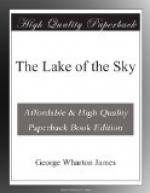Yellow Pine and Jeffrey Pine. These are practically one and the same, though the latter is generally regarded as a variety and the former the type. Mr. Leiberg says:
The two forms differ chiefly in the size of the cones, in the tint and odor of the foliage, and in the color and thickness of the bark, differences which are insufficient to constitute specific characters. The most conspicuous of the above differences is that in the size of the cones, which may seemingly hold good if only a few hundred trees are examined. But when one comes to deal with thousands of individuals the distinction vanishes. It is common to find trees of the Jeffrey type as to foliage and bark that bear the big cones, and the characteristic smaller cones of the typical yellow pine, both at the same time and on the same individual, while old cones strewn about on the ground indicate that in some seasons trees of the Jeffrey type produce only small-sized cones. The odor and the color of leaves and bark are more or less dependent on soil conditions and the inherent vitality of the individual tree, and the same characters are found in specimens belonging to the yellow and Jeffrey pine. It is noticeable that the big-cone variety preferably grows at considerable elevation and on rocky sterile ground, while the typical form of the yellow pine prevails throughout the lower regions and on tracts with a more generous soil.
The yellow pine has a wider range than any other of the Tahoe conifers, though on the high, rocky areas, south and west of Rubicon Springs it is lacking. It crosses from the western slopes to the eastern sides of the Sierras and down into the Tahoe basin over the heads of Miller and McKinney Creeks, in both places as a thin line, or rather as scattering trees mixed with Shasta fir and white pine.
It grows from sixty to two hundred and twenty-five feet high with trunk two to nine feet in diameter. The limbs in mature trees are horizontal or even drooping. The bark of typical trees is tawny yellow or yellow-brown, divided by fissures into large smoothish or scaly-surfaced plates which are often one to four feet long and one-half to one and a quarter feet wide. The needles are in threes, five to ten inches long; the cones reddish brown.
It must be noted, too, that “the bark is exceedingly variable, black-barked or brown-barked trees, roughly or narrowly fissured, are very common and in their extreme forms very different in trunk appearance from the typical or most-abundant ‘turtle-back’ form with broad, yellow or light brown plates.”—Jepson.
Lodge Pole Pine. The range of this tree is almost identical with that of the Shasta fir, though here and there it is found at as low an altitude as 4500 feet. It loves the margins of creeks, glades and lakes situated at altitudes of 6000 feet and upward, where it usually forms a fringe of nearly pure growth




